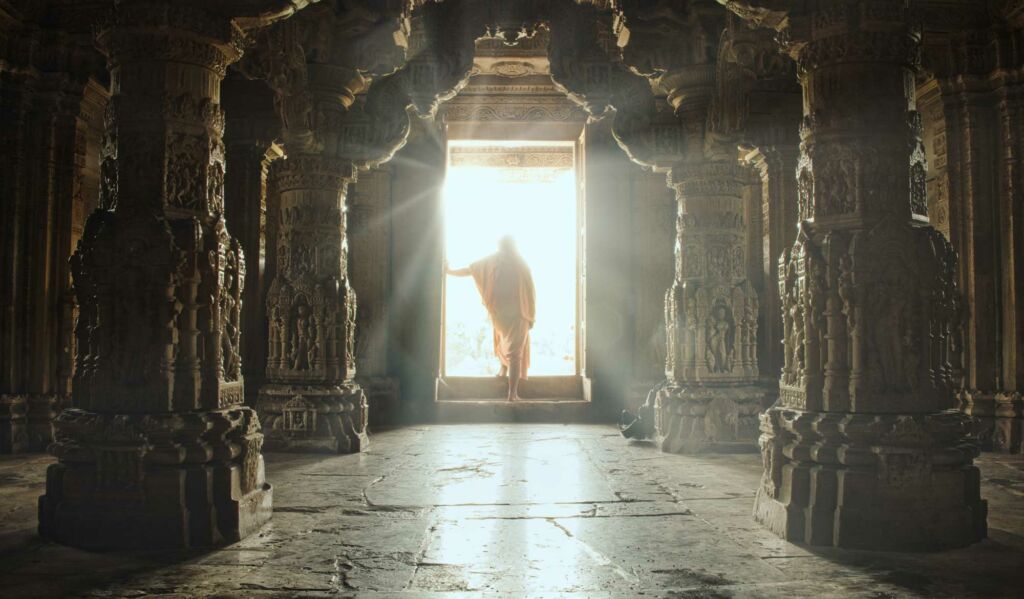Overview
Jñāna (‘Knowledge’) was first published in Sajjana Toṣaṇī, Vol.8, Issue 7 in 1897. Śrīla Bhaktivinoda Ṭhākura analyses what is jñāna and then defines the various types of jñāna specifically in relation to the jīva - in particular, he explains svabhāvaja-jñāna (inherent knowledge) and prasādaja-jñāna (knowledge born from mercy).
(translated by Swami B.V. Giri)
What is jñāna? There are many answers to this question. Some say that the experience that human senses perceive by touching objects is jñāna. Some say that the entire experience one attains through the perfection of aṣṭāṅga–yoga is jñāna. Some say that only the experience of Brahman is jñāna. Some scholars divide jñāna into two parts – one category they call ‘knowledge’ and the other category they call ‘wisdom.’ Actually, all these persons have not revealed the true and complete meaning of the word jñāna. They spend their time quibbling about the meaning of these categories.
Actually, jñāna is the only reality in this world. Although jñeya, the object of jñāna, is separate from jñāna itself, a knowable object is determined by jñāna. Thus, the immeasurable greatness of jñāna has been described in all places and in all śāstras. If the word jñāna is mentioned, then various concepts of jñāna, jñeya and parijñāta arise. One who experiences is the parijñāta (knower). That which is perceived is the jñeya (the object of knowledge). The act of perception itself is jñāna. If the knower is perceived by others, it belongs to the category of the object of knowledge. When jñāna is discussed using some other type of knowledge, then that jñāna becomes the object of knowledge. When the object of knowledge perceives another object, then it becomes the knower. Thus, jñāna is inherently one object which is related to three objects. It is unjust to think that in order to honour the intrinsic subject (jñāna) one must consider that which is related to it to be inferior. This is because the intrinsic subject, by its very existence, has the related qualities eternally present within it. The concept of merely accepting the intrinsic subject and denying everything related to it is incomplete. Not being able to understand this properly, then great anarthas in the form of māyāvāda, vivartavāda or kevalādvaitavāda arise in the heart of the jīva. Both an intrinsic nature and its relationships are simultaneously eternal. Thus, the nature of jñāna, jñeya and parijñātā are one indivisible reality which always exist in separate forms in all circumstances. Such contrary actions take place only due to Bhagavān’s acintya-śakti. It achieves harmony in this way. It is not comprehended by the jīva’s limited knowledge.
The Supreme Lord is complete jñāna personified. The jīva is the personification of limited jñāna. The Supreme Lord’s jñāna is not our concern. The jīva’s knowledge is our concern. Therefore, we will discuss the jīva’s knowledge and see how the elements of jñāna, jñeya and parijñāta are eternally present in the jīva.
The jīva’s knowledge is threefold. Whatever a jīva can experience is jīva–jñana. The two kinds of jīva are mukta (liberated) and baddha (bound). We are incapable of discerning the extent of the realm of experience of a mukta-jīva who has achieved the mercy of the Supreme Lord. We can only determine experience in relation to the baddha-jīva.
In the baddha-jīva there are three separate types of existence – the jīva’s svarūpa (inherent nature), the liṅga-rūpa (subtle body) and sthūla-rūpa (gross body). In gross existence the knowledge of the jīva is gathered by the five senses. The knowledge that the five senses gather by touching their respective objects is sthūla-satta-jñāna (knowledge of gross existence). When the same gross knowledge is brought to the internal sense, the mind, then the mind accepts or rejects, considers things to be important or unimportant etc, and through imagination and examination, a new classification of knowledge arises which is liṅga-satta-jñāna (knowledge of subtle existence). The esoteric knowledge of the subtle world that those who have achieved perfection in yoga acquire is also the jīva’s liṅga-satta-jñāna. The intrinsic nature of everything subtle and gross is material. It is not transcendental. That is why the yogīs cannot receive any news of the spiritual world. All the features that are comprised of light belong to the subtle world. Astral phenomena and splendour, in other words, the powers of aṇimā etc. are all bound to the subtle realm. The spiritual world has no close relationship with them. The jñāna which inherently exists within and emerges from the jīva is knowledge in relation to the spiritual world. Knowledge which is acquired through aṣṭāṅga–yoga, jñāna–yoga and other so-called types of yoga, are of no benefit to that jñāna. The jñāna which inherently exists within the jīva is ātma–tattva–jñāna (knowledge of the nature of the ātmā). This is of two types, namely that which is svabhāvaja and prasādaja.
Jñāna which arises from the inherent nature present within the jīva is his svabhāvaja-jñāna. This jñāna does not arise from either the subtle or gross existence. The jīva’s existence is a particle of the supreme conscious Substance. Therefore, a finite indication of the inherent nature of the Supreme Consciousness is found within the intrinsic nature of the jīvas. Another name for this intrinsic nature is dharma. The dharma of the Supreme Consciousness and the dharma of the jīva are one. The difference is only in quantity. The dharma which is fully and infinitely present eternally in the Supreme Consciousness is also eternally present to a finite degree in the jīvas. The Supreme and the jīva are identical in that they share similar attributes; thus their dharma is also identical with similar attributes. Gross dharma of subtle dharma does not exist within the Lord or the jīva. The dharma of accepting a gross body or a subtle body is merely a nature which the jīva is designated with – it is not inherent. The spiritual nature of the jīva is self-manifest. It is not manifest by the mind, intelligence and false ego which stem from the subtle body. It does not manifest from the senses of the gross body, or the light of the moon, sun or fire. Thus, jñāna which is derived from the gross senses or arising from the subtle mind, intelligence and false ego can never reveal the jīva or the Supreme Lord. Only that jñāna which is inherent in the jīva can reveal the jīva’s intrinsic nature.
Fire which is covered by ashes is not identified as ash. When the ashes are removed, one becomes acquainted with its own heat and light. When the gross and subtle forms of the jīva are removed, the jīva’s inherent nature is discovered. The ashes of the gross and subtle body are the two layers that cover the fire-like jīva. While these two layers are not removed, does the jīva possess no identity? Yes, it is there. By sitting near a fire covered with ashes one gets a small amount of heat, similarly the jīva;s identity is revealed to a certain extent even when covered with these two layers. That identity is as follows:
1) I am a personality, separate from the gross and subtle world.
2) My true relationships, hope, health and well-being are in a state beyond this gross and subtle world.
3) Although I have an independent existence, I am subordinate to one who possesses a greater independent existence.
4) I am always inherently attracted to He who possesses that greater independent existence.
5) Due to some offence, I am subjected to this unfortunate state.
6) It is necessary to free myself from that offence and attain my pure state.
7) The designation of that state is transcendental love alone.
8) I myself am very insignificant, therefore I am powerless. By following my Supreme Lord, I will gain strength with His help.
9) I have fallen very far, but due to His acintya-śakti, my Lord is not so far from me.
10) Being covered with the gross and subtle body, my present condition is distressful.
Jñāna, in the form of arguments based upon gross and subtle existence, displays its own strength and eventually neglects the ātmā’s original and correct inherent nature. When ātma–jñāna is strengthened through sādhu–saṅga and through the power of other types of sukṛti, then gross and subtle jñāna becomes weak and deceases. Such is the nature of svabhāvaja-jñāna.
Prasādaja-jñāna is of two types, namely bhagavat-prasādaja-jñāna and bhakta-prasādaja-jñāna. If the Supreme Lord is satisfied through bhakti-sādhana, He graciously grants unlimited jñāna to the jīva. The knowledge acquired in eternity through the power of yoga or manipulation of the senses does not equal even one particle of prasādaja-jñāna. By the grace of Bhagavān, a devotee acquires complete knowledge of the storehouse of transcendental knowledge. Whatever kind of knowledge the yogīs and materialistic scholars acquire through great effort is completely mundane. The highest attainment that a yogī achieves is kaivalya (oneness with the Supreme). Although it is certainly indicated to be the end of material knowledge, in no way is it transcendental jñāna. After breaking through that kaivalya and seeing the variagatedness of transcendence, one gets a taste of transcendental jñāna. It is impossible for a jīva to break through kaivalya by his own endeavours. It is difficult to cross beyond kaivalya without the grace of Bhagavān and His devotees.
Bhakta-prasādaja-jñāna is rare. Those devotees who, by the mercy of Bhagavān, enrich their inherent ātma-jñāna by attaining complete bhagavad-prasādaja-jñāna can, by transmitting their power, make a recipient of their mercy qualified to possess that transcendental storehouse of divine knowledge. Such association of devotees is rare for the jīvas, thus bhakta-prasādaja-jñāna is not so easily available everywhere. In conclusion, our statement is that jñāna is of three types:
1) Gross jñāna accumulated by the senses.
2) Subtle jñāna attained through yoga.
3) Transcendental jñāna which is inherently existing within the jīva.
Gross knowledge gathered by the senses is destroyed immediately with this gross body. All the jñāna accumulated through physics is bound for the same kind of destination. No matter how proud a materialistic scholar is, his ego and those things connected to his ego will all disappear at death. Being under the influence of petty pride, those who show contempt for transcendental jñāna, are only a particular nuisance because they lack proper knowledge. The limitations of subtle jñāna gained through yoga are useful only up to the limits of the subtle world. According to the result of his karma, while the jīva remains under the control of the subtle body, only the power of this knowledge remains. If the subtle body is dissolved, in other words, if one attains mukti, where does the mystic knowledge of yoga go? Therefore, knowledge acquired by yoga is not infinite. It has its limitations.
The transcendental jñāna which exists inherently within the jīva is eternal, unrestricted and without end. It is the duty of the jīva to strive for that knowledge. Therefore, Śrī Nārada instructed Śrī Vyāsadeva as follows:
tasyaiva hetoḥ prayateta kovido
na labhyate yad bhramatām upary adhaḥ
tal labhyate duḥkhavad anyataḥ sukhaṁ
kālena sarvatra gabhīra-raṁhasā
(Śrīmad Bhāgavatam 1.5.18)
“Thus, O Vyāsa, a discerning person strives for that tattva-jñāna (knowledge of reality) which cannot be obtained merely by wandering top of the universe to the bottom of it. Happiness is present in the material world – it is driven by the extremely powerful time factor, and like sorrow, it is achieved without any effort.”
The Śrīmad Bhāgavata is a book which bestows this knowledge of self-awareness. Thus, it is the essence of the teachings of the entire śruti. If there is a desire to acquire that divine knowledge which is inherently present within the jīva, then one should explore the storehouse of transcendental jñāna which has been entirely described in such a divine and astonishing manner in that book.













